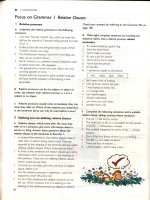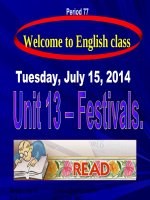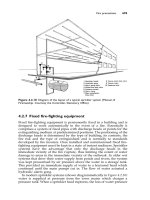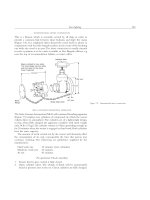Astm e 1517 13
Bạn đang xem bản rút gọn của tài liệu. Xem và tải ngay bản đầy đủ của tài liệu tại đây (64.42 KB, 2 trang )
Designation: E1517 − 13
Standard Test Method for
Determining the Effectiveness of Liquid, Gel, Cream, or
Shampoo Insecticides Against Human Louse Ova1
This standard is issued under the fixed designation E1517; the number immediately following the designation indicates the year of
original adoption or, in the case of revision, the year of last revision. A number in parentheses indicates the year of last reapproval. A
superscript epsilon (´) indicates an editorial change since the last revision or reapproval.
1. Scope
3.3 Percent egg mortality, corrected by Abbott’s Formula, is
determined.
1.1 This test method determines the effectiveness of ovicidal materials in liquid, gel, cream, or shampoo form against the
ova (that is, eggs or nits) of the human louse, Pediculus
humanus.
4. Significance and Use
4.1 This test method is a standardized test for the gathering
of efficacy data for human louse ovicides.
1.2 This test method is intended for use by those wishing to
develop efficacy data or compare ovicidal formulations for
human louse ova control.
4.2 Data collection in this manner is suitable for product
development and comparison, and for review by regulatory
agencies, to support the registration of human louse ovicidal
products.
1.3 This test method consists of five replicates for a statistical comparison of formulations.
1.4 The values stated in SI units are to be regarded as
standard. No other units of measurement are included in this
standard, except for temperature measurements in Section 5.
1.5 This standard does not purport to address all of the
safety concerns, if any, associated with its use. It is the
responsibility of the user of this standard to establish appropriate safety and health practices and determine the applicability of regulatory limitations prior to use.
5. Apparatus and Materials
5.1 Applicators—Egg-infested hairs are attached to the end
of a wooden applicator stick with duct tape such that 30 nits are
on 1 to 3 hairs. Each replicate of 30 eggs is examined under a
dissecting microscope to confirm viability. Any eggs that are
shrunken or with other indications of being nonviable are
excluded.
5.2 Beakers—A 100-mL beaker is used to contain 60 mL of
test ovicide and another to contain 60 mL of water (control),
into which the applicators are submerged. A 1000-mL beaker is
used for washing the eggs.
2. Terminology
2.1 Definitions of Terms Specific to This Standard:
2.1.1 hatched—those eggs (nits) from which the nymph has
emerged completely; an empty, clear egg case with the
operculum clearly open.
2.1.2 unhatched—those eggs that are opaque; the operculum
is closed or the nymph is partly emerged.
5.3 Heating Surface—A slide dryer that provides heat of
approximately 32°C (90°F).
5.4 Incubator, capable of maintaining a temperature of 31.7
6 0.5°C (89°F) and a relative humidity of 60 6 10 %.
3. Summary of Test Method
5.5 Water Bath, capable of maintaining a temperature of
32°C (90°F).
3.1 Five replicates of 30 eggs are immersed in a test
compound for a set period of time, washed, rinsed, blotted dry,
and incubated.
5.6 Wash Bottle, Stop Watch, and Dissecting Scope.
5.7 Test Insect—The human louse, Pediculus humanus.2
3.2 Five control replicates are attached to human hair and
processed as the treatment replicates, but with immersion in
water.
5.8 Positive Control Treatment (Optional)—60 mL of solution known to give 65 to 95 % mortality of louse eggs when
used under these test conditions.
1
This test method is under the jurisdiction of ASTM Committee E35 on
Pesticides, Antimicrobials, and Alternative Control Agents and is the direct
responsibility of Subcommittee E35.12 on Insect Control Agents.
Current edition approved April 1, 2013. Published April 2013. Originally
approved in 1993. Last previous edition approved in 2006 as E1517 – 99 (2006).
DOI: 10.1520/E1517-13.
2
A strain of the human body louse, Pediculus humanus, is maintained by Insect
Control and Research, Inc., Baltimore, MD 21228-1199. The strain was established
from a U.S. Department of Agriculture Gainesville colony. It is a susceptible strain
and, through selection, has been adapted to the New Zealand White rabbit.
Copyright © ASTM International, 100 Barr Harbor Drive, PO Box C700, West Conshohocken, PA 19428-2959. United States
1
E1517 − 13
hatch. Failure to hatch is recorded as mortality. Categorize eggs
failing to hatch as follows:
7.10.1 Early stage (no visible differentiation of the embryo
when viewed under 30×);
7.10.2 Late stage (visible differentiation of embryo when
viewed under 30×, typically eye spot is visible); and
7.10.3 Emergent (nymphal louse has opened operculum and
begun to emerge, but died before emerging completely—part
of nymph’s body still within egg shell).
6. Rearing of Test Insects
6.1 The adult human lice are blood fed on the shaven belly
of a restrained rabbit.
6.2 The lice are transferred to human hair cuttings, held in
a petri dish, and incubated for 24 h for oviposition to occur.
6.3 The lice are then allowed to crawl off the egg-infested
hairs by placing them on a rabbit’s belly, leaving the hairs with
attached eggs for exposure.
8. Analysis of Data
7. Procedure
8.1 Calculate the percentage of control eggs failing to hatch;
if this exceeds 15 %, the results should be discarded and the
test repeated.
7.1 Use five replicates of each test formulation and five
control replicates.
7.2 Prepare 5 cohorts of eggs for each treatment to be tested
including the control treatments. Each cohort consists of 30
eggs (one to three hair shaft(s)) attached with duct tape to a
wood applicator stick.
8.2 Correct all counts of treated eggs failing to hatch by
Abbott’s Formula (corrected % killed = (% alive control %
alive treated) ì 100 % ữ % alive control).3 Confirm that the
corrected mortality experienced by the positive controls is 65
to 95 %; if it is not, the results should be discarded and the test
repeated.
7.3 Heat the test samples to 32 6 1°C in the waterbath.
7.4 Insert the taped ends (hairs) of the applicator sticks into
the test samples for 10 min of immersion.
8.3 Mortality data will be analyzed by appropriate statistical
procedures, such as analysis of variance (ANOVA), followed
by a standard statistical test to separate the means.
7.5 Wash the eggs in 900 mL of 32°C tap water for 1 min by
vigorous up and down movement of the applicator sticks with
the hairs attached.
9. Precision and Bias
7.6 Rinse the eggs with water from the wash bottle for 1
min.
9.1 No precision data are available for this test method;
however, ASTM Committee E35 is interested in conducting an
interlaboratory test program and encourages interested parties
to contact the staff manager, Committee E35, ASTM Headquarters.
7.7 Blot excess water with paper toweling.
7.8 Transfer the hair with attached eggs to labelled petri
dishes and incubate.
7.9 Follow the same procedure for the control replications,
except substitute tap water for the test solution.
10. Keywords
10.1 effectiveness; human louse ovicides; insecticides
7.10 When all control eggs have hatched (after approximately 12 days), examine all replicates under a dissecting
microscope to determine the numbers hatching and failing to
3
Finney, D., Probit Analysis, Cambridge University Press, Cambridge, England,
1962, pp. 88–92.
ASTM International takes no position respecting the validity of any patent rights asserted in connection with any item mentioned
in this standard. Users of this standard are expressly advised that determination of the validity of any such patent rights, and the risk
of infringement of such rights, are entirely their own responsibility.
This standard is subject to revision at any time by the responsible technical committee and must be reviewed every five years and
if not revised, either reapproved or withdrawn. Your comments are invited either for revision of this standard or for additional standards
and should be addressed to ASTM International Headquarters. Your comments will receive careful consideration at a meeting of the
responsible technical committee, which you may attend. If you feel that your comments have not received a fair hearing you should
make your views known to the ASTM Committee on Standards, at the address shown below.
This standard is copyrighted by ASTM International, 100 Barr Harbor Drive, PO Box C700, West Conshohocken, PA 19428-2959,
United States. Individual reprints (single or multiple copies) of this standard may be obtained by contacting ASTM at the above
address or at 610-832-9585 (phone), 610-832-9555 (fax), or (e-mail); or through the ASTM website
(www.astm.org). Permission rights to photocopy the standard may also be secured from the ASTM website (www.astm.org/
COPYRIGHT/).
2









